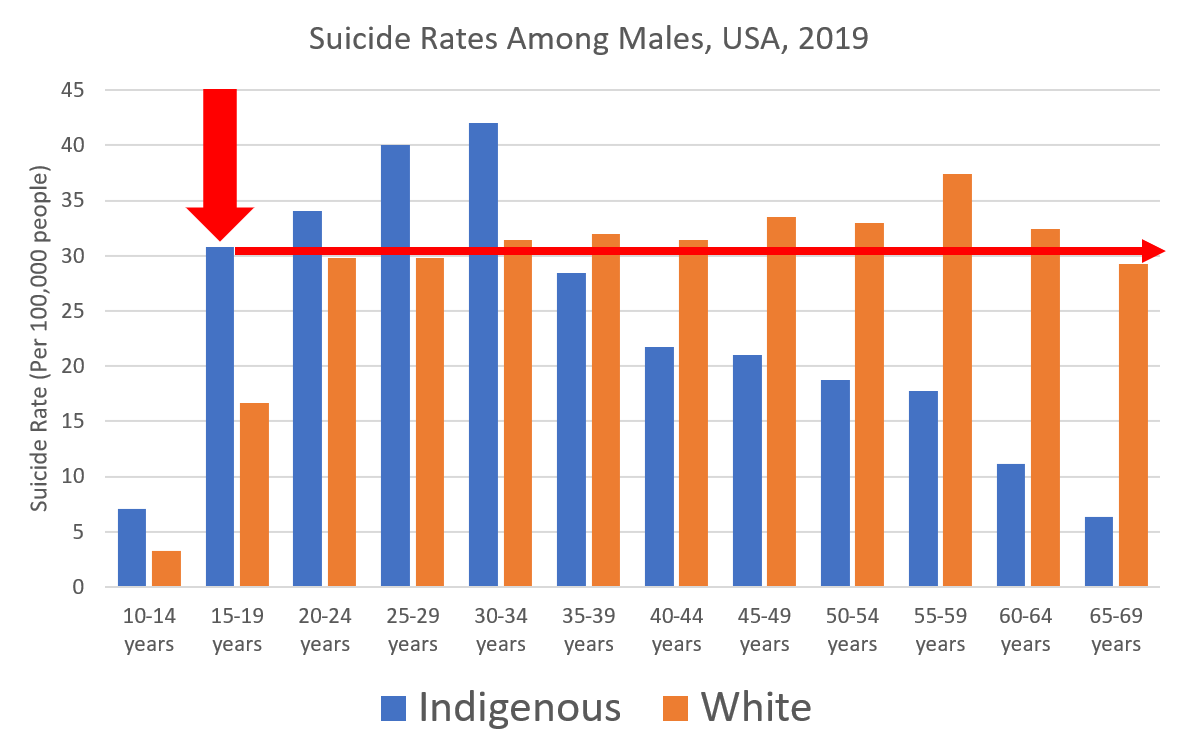
/1 Thread: Do better, American Suicide Organizations.
(content warning, obviously!)
If @afspnational incorrectly states "White middle age" as the peak rate of suicide, ignoring the Indigenous youth/young adult suicide crisis, that's a fail. Part of systemic racism.
4 Pics:



(content warning, obviously!)
If @afspnational incorrectly states "White middle age" as the peak rate of suicide, ignoring the Indigenous youth/young adult suicide crisis, that's a fail. Part of systemic racism.
4 Pics:




/2 LOOK AT THIS! AHHHHH! How could a major national organization not put this front and center about statistics?!?!
The rate of 15-19 year old Indigenous males is as high as almost EVERY white age bracket!
The rate of 15-19 year old Indigenous males is as high as almost EVERY white age bracket!

/3 For the past 21 years, the highest rate of suicide is Indigenous males, by 7%. The peak rate is between 18-27y at 33.6/100k
For White males, the "middle age peak" between 48-57 is 31.5/100k.
Since I've looked, I've not seen the AFSP mention this in their statistics page.
For White males, the "middle age peak" between 48-57 is 31.5/100k.
Since I've looked, I've not seen the AFSP mention this in their statistics page.

/4 For both sexes, no change. It has been well established for 21 years that the peak suicide rate is among younger Indigenous Americans.
Suicide rates of Indigenous children 8-17 (6.4 per 100k) ARE MORE THAN DOUBLE the rate of White children (3.1 per 100k) .
Suicide rates of Indigenous children 8-17 (6.4 per 100k) ARE MORE THAN DOUBLE the rate of White children (3.1 per 100k) .

/5 If one wants to be statistically conservative, at the VERY LEAST one should say there are two peak groups of suicide: middle aged White males and young Indigenous males.
/6 Instead, American media and organizations largely ignore Indigenous Suicide, and advocacy focuses on "White Males."
I've been called for many stories about suicide by reporters. Few have asked about Indigenous rates. Many have asked about White males.
Media, do better.


I've been called for many stories about suicide by reporters. Few have asked about Indigenous rates. Many have asked about White males.
Media, do better.



/7 Let's go to the @AASuicidology website!
In the statistics section, no peak rate talk, but they do mention the overall lifetime risk being higher for White Men (26.1 per 100k, which is true).
Despite the youth peak, no mention of Indigenous suicides.
In the statistics section, no peak rate talk, but they do mention the overall lifetime risk being higher for White Men (26.1 per 100k, which is true).
Despite the youth peak, no mention of Indigenous suicides.

/8 Maybe I missed something, but none of the media briefs I saw, no press releases to 2019 mention Indigenous suicide.
Their data sheet? Of all the important info not 1 mention of youth Indigenous suicide.
suicidology.org/wp-content/upl…
Their data sheet? Of all the important info not 1 mention of youth Indigenous suicide.
suicidology.org/wp-content/upl…
/9 Yes it is absolutely true that most suicides in America are among White Americans. But minoritization is real and if we focus on large groups we will always miss minorities that suffer.
In terms of years of life lost, it's staggering what is being ignored in America.
In terms of years of life lost, it's staggering what is being ignored in America.
/10 Taking all suicides between 1999-2019, we can do a Years of Life Lost (YLL) calculation using 2018 expectancy:
Years of Life Lost to Suicide (Rate):
White
50.7 YLL/10,000 person-years
Indigenous
59.0 YLL/10,000 person-years
That's **16.4% higher**
Years of Life Lost to Suicide (Rate):
White
50.7 YLL/10,000 person-years
Indigenous
59.0 YLL/10,000 person-years
That's **16.4% higher**
/11 When discussing Indigenous suicide, it's important to remember that being Indigenous is NOT a risk factor for suicide. Being Indigenous in a racist society is. This Statistics Canada data shows that social factors adjust suicide rate changes back to non-Indigenous rates. 

/12 And lest we in Canada thumb feel superior to the American situation, it is very very very bad in Canada.
For Inuit, the rate is NINE times higher (72.3 per 100,000) than non-Indigenous people (8.1 per 100,000)
For Inuit, the rate is NINE times higher (72.3 per 100,000) than non-Indigenous people (8.1 per 100,000)
• • •
Missing some Tweet in this thread? You can try to
force a refresh














